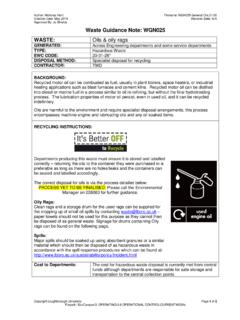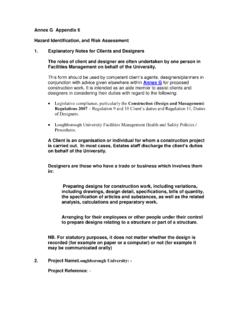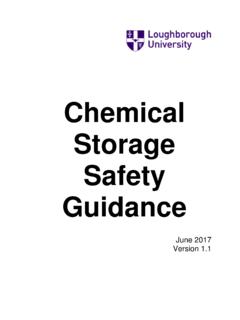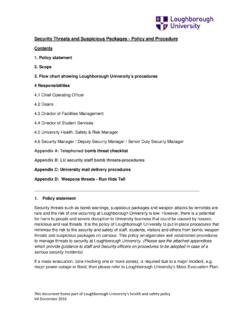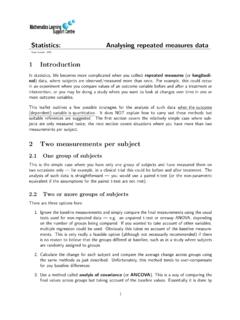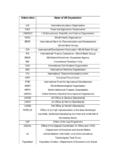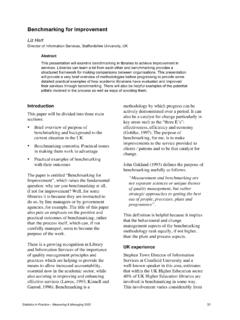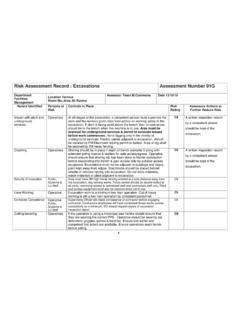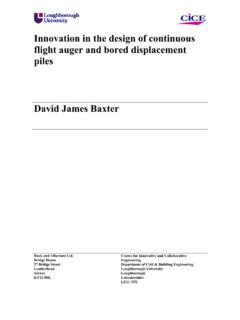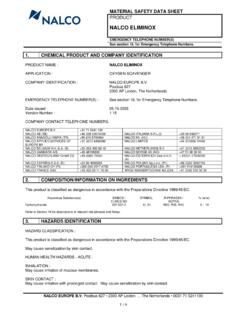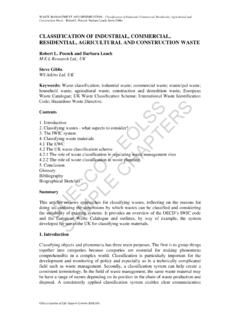Transcription of Appendix A: Consolidated List of Waste
1 AA1 A Environment Agency Hazardous Waste : Interpretation of the definition and classification of hazardous Waste (3rd edition 2013) Appendix A: Consolidated List of Waste The aim of this Appendix is to reproduce in full the List of Waste , including the legal instructions on its use, and give additional guidance on certain aspects of its use. The outcome of choosing the most appropriate entry in the list will help you decide whether you have a Waste that is automatically hazardous, a Waste that is automatically non-hazardous or a Waste that you will have to do a full assessment on a so-called ' mirror entry' Waste . The structure of the List of Waste (LoW) The LoW was established by Commission Decision 2000/532/EC1. It consists of 20 chapters that must be used in a certain order of precedence. Some chapters relate to processes that generate Waste and some refer to specific Waste types.
2 The chapter headings are given a two-digit number as shown in table below. An example of a chapter is: 20 MUNICIPAL WASTES (HOUSEHOLD Waste AND SIMILAR COMMERCIAL, INDUSTRIAL AND INSTITUTIONAL WASTES) INCLUDING SEPARATELY COLLECTED FRACTIONS. Each chapter of the LoW contains sub-chapters that are identified by four-digits, for example: 20 01 Separately collected fractions (except 15 01) Within each sub-chapter is a list of Waste types each given a unique six digit code, for example: 20 01 01 paper and cardboard AN2 For a Waste to be given a particular LoW code, reference must be made to the 2, 4 and 6 digit entries. In the case of 20 01 01 the Waste must: be paper or cardboard or a mixture of paper and cardboard be kept separately from other wastes when collected from a household (or is Waste similar to that produced by a household), and not be packaging Waste (which would be coded in sub-chapter 15 01 even if from a household) If the Waste does not meet all four of the above criteria 20 01 01 would not be the most appropriate code.
3 1 Commission Decision 2000/532/EC as amended by 2001/118/EC, 2001/119/EC and 2001/573/EC. A Consolidated version can be found at 2 For a description of what AN, AH, MH and MN means see Section Environment Agency Hazardous Waste : Interpretation of the definition and classification of hazardous Waste (3rd edition 2013) AA2 C Table :H1 List of Waste chapters and their order of precedence Code Chapter Description Order of precedence 01 WASTES RESULTING FROM EXPLORATION, MINING, QUARRYING, AND PHYSICAL AND CHEMICAL TREATMENT OF MINERALS 1 02 WASTES FROM AGRICULTURE, HORTICULTURE, AQUACULTURE, FORESTRY, HUNTING AND FISHING, FOOD PREPARATION AND PROCESSING 1 03 WASTES FROM WOOD PROCESSING AND THE PRODUCTION OF PANELS AND FURNITURE, PULP, PAPER AND CARDBOARD 1 04 WASTES FROM THE LEATHER, FUR AND TEXTILE INDUSTRIES 1 05 WASTES FROM PETROLEUM REFINING, NATURAL GAS PURIFICATION AND PYROLYTIC TREATMENT OF COAL 1 06 WASTES FROM INORGANIC CHEMICAL PROCESSES 1 07 WASTES FROM ORGANIC CHEMICAL PROCESSES 1 08 WASTES FROM THE MANUFACTURE, FORMULATION, SUPPLY AND USE (MFSU) OF COATINGS (PAINTS, VARNISHES AND VITREOUS ENAMELS)
4 , ADHESIVES, SEALANTS AND PRINTING INKS 1 09 WASTES FROM THE PHOTOGRAPHIC INDUSTRY 1 10 WASTES FROM THERMAL PROCESSES 1 11 WASTES FROM CHEMICAL SURFACE TREATMENT AND COATING OF METALS AND OTHER MATERIALS, NON-FERROUS HYDRO-METALLURGY 1 12 WASTES FROM SHAPING AND PHYSICAL AND MECHANICAL SURFACE TREATMENT OF METALS AND PLASTICS 1 13 OIL WASTES AND WASTES OF LIQUID FUELS (except edible oils, and those in chapters 05, 12 and 19) 2 14 Waste ORGANIC SOLVENTS, REFRIGERANTS AND PROPELLANTS (except 07 and 08) 2 15 Waste PACKAGING, ABSORBENTS, WIPING CLOTHS, FILTER MATERIALS AND PROTECTIVE CLOTHING NOT OTHERWISE SPECIFIED 2 16 WASTES NOT OTHERWISE SPECIFIED IN THE LIST 3 17 CONSTRUCTION AND DEMOLITION WASTES (INCLUDING EXCAVATED SOIL FROM CONTAMINATED SITES) 1 18 WASTES FROM HUMAN OR ANIMAL HEALTH CARE AND/OR RELATED RESEARCH (except kitchen and restaurant wastes not arising from immediate health care) 1 19 WASTES FROM Waste MANAGEMENT FACILITIES, OFF-SITE Waste WATER TREATMENT PLANTS AND THE PREPARATION OF WATER INTENDED FOR HUMAN CONSUMPTION AND WATER FOR INDUSTRIAL USE 1 20 MUNICIPAL WASTES (HOUSEHOLD Waste AND SIMILAR COMMERCIAL, INDUSTRIAL AND INSTITUTIONAL WASTES) INCLUDING SEPARATELY COLLECTED FRACTIONS 1 AA3 A Environment Agency Hazardous Waste : Interpretation of the definition and classification of hazardous Waste (3rd edition 2013) Choosing a code from the LoW the order of precedence of chapter use There are 839 Waste entries in the LoW and choosing a code for a Waste can be complicated.
5 It is important to understand that the LoW is not a look up list. You must; consider the entire list, rather than focussing on a single process chapter, and use the chapters in the order of preference specified in Commission Decision 2000/532/EC (set out in steps 1 to 5 below) to enable you to identify the appropriate code for your Waste . Step 1 Identification by Waste source Chapters 01 to 12 and 17 to 20 refer specifically to industry process Waste and municipal Waste . If your Waste falls into one of these chapters, and is listed there with one or more applicable entries, you should use the most appropriate code for your Waste . If, for example, you have a chemical surface treatment process that produces Waste aqueous rinse waters, you could code them as either: 11 01 11* aqueous rinsing liquids containing dangerous substances MH 11 01 12 aqueous rinsing liquids other than those mentioned in 11 01 11 MN The decision as to which of these entries you would choose is discussed below in Step 5.
6 You must not use a six digit 99 entry at Step 1 because more appropriate entries might be found in other chapters. Step 2 Identification by Waste type If no appropriate entry is found in chapters 01 to 12 or 17 to 20, then you should check chapters 13, 14 and 15 to see if the Waste is listed there. These chapters contain oil wastes; solvent wastes; and Waste packaging, absorbents, filter materials, wiping cloths and protective clothing. Step 3 Other general wastes If Waste is not found in chapters 01 to 15 or 17 to 20, then chapter 16 might contain the most appropriate code. Chapter 16 contains a lot of general wastes such as vehicles, electronic equipment and batteries, as well as a number of chemical wastes like catalysts, laboratory chemicals and oxidisers. Step 4 Non-specific wastes Sometimes wastes cannot be found specifically in the LoW.
7 If a Waste is from one of the industry processes 01 to 12 and 17 to 20, you can now use the 99 code that you were not able to use in Step 1. An example of a Waste that is coded 99 is a separate fraction of municipal hygiene wastes (20 01 99). However you should use the most appropriate code, so should not use a 99 code if a suitable alternative is available in another chapter of the catalogue . For example amalgam Waste from veterinary healthcare care should be coded 18 01 10*, even though that code relates to human healthcare, as it is clearly suitable. Environment Agency Hazardous Waste : Interpretation of the definition and classification of hazardous Waste (3rd edition 2013) AA4 C Step 5 Hazardous Waste classification Some of the six-digit codes in the LoW have an asterisk (*) next to them; these are hazardous wastes. Wastes without an asterisk are non-hazardous Waste .
8 In the LoW there are three types of entry: entries coloured in red and labelled AH; they are known as "absolute hazardous" wastes entries coloured in black and labelled AN; they are known as "absolute non-hazardous wastes" entries known as "mirror entries" Absolute hazardous (AH) entries These wastes are marked in the List with an asterisk (*) but the Waste description next to the six-digit code does not have a "specific" or "general" reference to "dangerous substances in their Waste description. They are automatically considered hazardous. You do not need to work out what chemicals are in the Waste to find out if it is hazardous or not. You must still find what (if any) hazardous properties the Waste has for consignment and transport purposes. We call these "absolute entries", and they are colour-coded red in WM2 Appendix A.
9 For example: 13 07 01* fuel oil and diesel AH Absolute non-hazardous (AN) entries If an entry in the list is not listed with an asterisk, and it does not have any link to a mirror or absolute hazardous entry, the entry is automatically not hazardous. An example is: 03 01 01 Waste bark and cork AN Mirror entries Mirror entries are typically divided into two: entries coloured in blue and labelled MH; they are known as "mirror hazardous wastes entries coloured in green and labelled MN; they are known as "mirror non-hazardous wastes Mirror hazardous (MH) and mirror non-hazardous (MN) entries Some wastes are not automatically hazardous or non-hazardous; they are called mirror entry wastes. These wastes have: a hazardous Waste entry (or entries) marked with an asterisk (*), and an alternative paired non-hazardous Waste entry (or entries) not marked with an asterisk Key Point : Absolute Hazardous Wastes with No Hazardous Properties A Waste that falls under an absolute hazardous entry ( any non-edible oil) is always hazardous.
10 If that Waste has no hazardous properties the absolute hazardous entry still applies. The law does not allow another entry to be applied to that Waste . AA5 A Environment Agency Hazardous Waste : Interpretation of the definition and classification of hazardous Waste (3rd edition 2013) A hazardous mirror has a "specific or "general reference to "dangerous substances in its Waste description. For example: 07 01 11* sludges from on-site effluent treatment containing dangerous substances MH The non-hazardous mirror usually (but not always) has a defined link to its mirror using the words "other than those mentioned in .. For example: 07 01 12 sludges from on-site effluent treatment other than those mentioned in 07 01 11 MN This is an example of a mirror pair where the hazardous entry has a "general reference to a dangerous substance(s). Th e hazardous entry is chosen if this Waste contains any dangerous substance(s) at or above levels that make it hazardous.
